|
|
|
Sort Order |
|
|
|
Items / Page
|
|
|
|
|
|
|
| Srl | Item |
| 1 |
ID:
176796
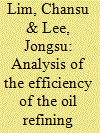

|
|
|
|
|
| Summary/Abstract |
This study investigated the efficiency of the oil refining industry using the two-stage method of Markowitz portfolio optimization theory and panel data analysis of about 30 OECD countries from 2005 to 2016, which is a new methodology for measuring the efficiency of the oil industry. The oil refining industry's efficiency is derived from the prices of petroleum products (Naphtha, Gasoline, Kerosene, Diesel, and Fuel Oil) using the portfolio theory. The panel data was constructed using the following dependent variables, the crude oil production efficiency, energy consumption, renewable energy consumption, and R&D investment. Using the panel data analysis, empirical analyzes are conducted on how the efficiency of the oil refining industry is affected by explanatory variables. The results show that crude oil production and energy use in OECD countries have a negative effect on the efficiency of the oil refining industry, and consumption of renewable energy and R&D investment have a positive effect. Contrary to conventional perception, the petroleum industry can coexist with the renewable energy industry for sustainable development.
|
|
|
|
|
|
|
|
|
|
|
|
|
|
|
|
| 2 |
ID:
170106
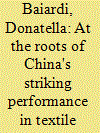

|
|
|
|
|
| Summary/Abstract |
This paper analyzes the determinants of China's striking performance in textile exports in the time period 2001–2016. We integrate the analysis by Lall and Albaladejo (World Development, 2004), based only on China and its main Asian competitors' market share dynamics, by estimating an extended version of a traditional export function, derived from the imperfect substitute model, including a proxy of non-price competitiveness. The key long-run elasticities for each Asian exporter are thus computed and discussed in a panel-data framework, and the different export performances are examined taking into account the interaction between the estimated parameters and the growth rates of relative prices, foreign demand and product quality. Lastly, we decompose the textile export growth differences between China and its rivals into the three main channels of trade competition, i.e. price, quantity and quality. Our findings show that China is crowding out most of its rivals with a competitive strategy based on a mix of low and decreasing relative prices and non-price policies aiming at stimulating export volumes. However, certain weaknesses in the Chinese trade prospects emerge when quality improvement is considered.
|
|
|
|
|
|
|
|
|
|
|
|
|
|
|
|
| 3 |
ID:
097504


|
|
|
|
|
| Publication |
2010.
|
| Summary/Abstract |
This study analyses original panel data from 86 countries between 1985 and 2006. Econometric methods were used to identify the effects of different policy devices of power sector reforms on performance indicators (installed capacity per capita, transmission and distribution loss) in the countries analyzed. The research findings suggest that reform variables such as the entry of independent power producers (IPPs), unbundling of generation and transmission, establishment of regulatory agencies, and the introduction of a wholesale spot market are the driving forces of increasing generation capacity, as well as reducing transmission and distribution loss in the respective regions. In this study, we can assume that, firstly, different electric industry's reform policies/measures have different impacts on geographically and economically diverse countries. Secondly, a country's state of economic development has a different impact on policy effects of reforms. Thirdly, coexistent with independent regulatory agencies, reform policy becomes more powerful in realizing sector performances.
|
|
|
|
|
|
|
|
|
|
|
|
|
|
|
|
| 4 |
ID:
166482
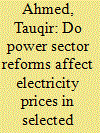

|
|
|
|
|
| Summary/Abstract |
This paper examines the impact of power sector reforms on electricity prices using panel data for selected Asian countries over the period 1970–2017. We estimate two separate models for domestic and industrial prices. Our results from pooled OLS and the random effect model show that the impact of independent power producers, privatisation, restructuring, and deregulation on electricity prices is negative and significant, making both domestic and industrial consumers better off. However, the welfare effects of unbundling generation from transmission and distribution appear to be beneficial for residential end-users only. Our results also indicate that other reform indicators including third-party access and the existence of independent regulatory agencies may not be the right choice for a reduction in electricity prices, given the absence of a requisite conducive environment for regulations in our sample countries. Thus, the inconsistent behaviour of different regulatory reforms towards different countries and regions of the world needs to be considered in the policy formulation of the power sector. We also note that the results can be magnified in terms of significance with the exclusion of some outlier observations in the data.
|
|
|
|
|
|
|
|
|
|
|
|
|
|
|
|
| 5 |
ID:
149847


|
|
|
|
|
| Summary/Abstract |
Applying recent advances in panel data analysis, we investigate the relationship between electricity consumption and economic growth in the GCC countries using annual data from 1975 to 2012. Within a framework which takes into consideration dynamics, heterogeneity and cross-sectional dependence in the panel, we show that the results obtained from using the PMGE, demeaned PMG, AMG, MGE and DFE models indicate a long-run equilibrium relationship between electricity consumption and economic growth. In order to determine the appropriate model and decide the preferred estimator, the Hausman test was performed. The PMGE model emerged as the most efficient of the three estimators. Also, the results obtained revealed a bi-directional causality between economic growth and electricity consumption in these countries, which supports the feedback hypothesis. As a result, this implies that if these countries adopt or implement any energy or electricity conservation policies, this may have a negative impact on its economic growth.
|
|
|
|
|
|
|
|
|
|
|
|
|
|
|
|
| 6 |
ID:
132636


|
|
|
|
|
| Publication |
2014.
|
| Summary/Abstract |
In recent years, sustainability has represented one of the most important policy goals explored in the environmental Kuznets curve (EKC) literature. But related hypotheses, performance measures and results continue to present a challenge. The present paper contributes to this ongoing literature by studying two different EKC specifications for 10 Middle East and North African (MENA) countries over the period 1990-2010 using panel data methods. For the first specification, namely EKC, we show that there is an inverted U-shape relationship between environmental degradation and income; while for the second specification, namely modified EKC (MEKC), we show that there is an inverted U-shape relationship between sustainability and human development (HD). The relationships are shaped by other factors such as energy, trade, manufacture added value and the role of law. More interestingly, findings from the estimation show that EKC hypothesis, HD and sustainability are crucial to build effective environmental policies.
|
|
|
|
|
|
|
|
|
|
|
|
|
|
|
|
| 7 |
ID:
166494


|
|
|
|
|
| Summary/Abstract |
Addressing consumption-based CO2 emissions, often called CO2 requirements, of households is key for developing a low carbon society. In this study, we analyzed the factors influencing these consumption-based CO2 emissions of households in Thailand. Household survey data, economic input-output tables, and panel data regression analyses for the years 1995–2010 were used to investigate the effects of socio-economic and demographic factors on energy and CO2 requirements of households in Thailand. The empirical results showed that socio-economic and demographic factors influenced the changes in energy and CO2 requirements. Temperature is the most significant factor influencing energy and CO2 requirements (a 1 °C increase in temperature resulted in a 200% increase in energy and CO2 requirements). Education is a key driving factor which positively influenced direct energy and CO2 requirements but negatively influenced the indirect energy and CO2 requirements. Our results provide important information for decision makers on how socio-economic and demographic factors influence consumption-based CO2 emissions of households in Thailand. Since most household-related energy policies in Thailand are voluntary in nature, the awareness, education and behavioral aspects need to be thought through more carefully when designing efficient policies towards low energy and low carbon society.
|
|
|
|
|
|
|
|
|
|
|
|
|
|
|
|
| 8 |
ID:
123340


|
|
|
|
|
| Publication |
2013.
|
| Summary/Abstract |
Despite the impressive magnitude of inward FDI in China, empirical studies on its spillover effects are relatively scarce and have failed to find conclusive evidence. By exploring a vast firm-level panel dataset, this study aims to test empirically whether the horizontal and vertical FDI spillover effects are different among industries classified by their technological levels. Key findings are as followings: First, foreign investments in the same industry are more likely to engender negative influences on the local Chinese firms. Second, these negative horizontal effects are particularly prominent in low technology sectors. Third, the effects of foreign investments in other industries appear to be positive and significant relatively evenly across industries with different technological levels. Considered in the context of Chinese policies on FDI, these findings suggest that government policies could be a crucial factor in taking advantage of FDI spillovers.
|
|
|
|
|
|
|
|
|
|
|
|
|
|
|
|
| 9 |
ID:
186414


|
|
|
|
|
| Summary/Abstract |
An increasing number of countries use auctions to allocate support for renewable energies. One major objective of policymakers when designing auctions is support cost efficiency, i.e., achieving low awarded prices. Based on a holistic database with auction outcomes from Europe covering the years 2012–2020, we conduct a fixed effects panel data regression to assess the effects of several auction design elements on the awarded prices. According to our results, policymakers aiming for low prices in renewable energy auctions should avoid restricting auctions to small-scale projects, implement ceiling prices, and ensure high levels of competition. Multi-technology auctions can also lead to higher efficiency, while quotas should be avoided. While PV tends to achieve lower prices in auctions restricted to small-scale projects, onshore wind performs better in auctions open to large-scale projects. Feed-in premia, multi-criteria auctions and allowing bidders to deviate from their awarded project capacity show no significant impact. The introduction of financial prequalification requirements and the length of the realisation period should be chosen carefully, as their effects are interrelated. While our results for individual design elements are largely in line with existing literature, we are able to produce new insights on the interdependencies between various auction design elements.
|
|
|
|
|
|
|
|
|
|
|
|
|
|
|
|
| 10 |
ID:
097505
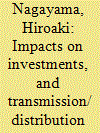

|
|
|
|
|
| Publication |
2010.
|
| Summary/Abstract |
This study analyses original panel data from 86 countries between 1985 and 2006. Econometric methods were used to identify the effects of different policy devices of power sector reforms on performance indicators (installed capacity per capita, transmission and distribution loss) in the countries analyzed. The research findings suggest that reform variables such as the entry of independent power producers (IPPs), unbundling of generation and transmission, establishment of regulatory agencies, and the introduction of a wholesale spot market are the driving forces of increasing generation capacity, as well as reducing transmission and distribution loss in the respective regions. In this study, we can assume that, firstly, different electric industry's reform policies/measures have different impacts on geographically and economically diverse countries. Secondly, a country's state of economic development has a different impact on policy effects of reforms. Thirdly, coexistent with independent regulatory agencies, reform policy becomes more powerful in realizing sector performances.
|
|
|
|
|
|
|
|
|
|
|
|
|
|
|
|
| 11 |
ID:
096712
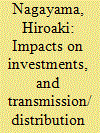

|
|
|
|
|
| Publication |
2010.
|
| Summary/Abstract |
This study analyses original panel data from 86 countries between 1985 and 2006. Econometric methods were used to identify the effects of different policy devices of power sector reforms on performance indicators (installed capacity per capita, transmission and distribution loss) in the countries analyzed. The research findings suggest that reform variables such as the entry of independent power producers (IPPs), unbundling of generation and transmission, establishment of regulatory agencies, and the introduction of a wholesale spot market are the driving forces of increasing generation capacity, as well as reducing transmission and distribution loss in the respective regions. In this study, we can assume that, firstly, different electric industry's reform policies/measures have different impacts on geographically and economically diverse countries. Secondly, a country's state of economic development has a different impact on policy effects of reforms. Thirdly, coexistent with independent regulatory agencies, reform policy becomes more powerful in realizing sector performances.
|
|
|
|
|
|
|
|
|
|
|
|
|
|
|
|
| 12 |
ID:
166571


|
|
|
|
|
| Summary/Abstract |
This study examines whether energy security contributes to economic growth for a global sample of 74 countries covering the period from 2002 to 2013. The benchmark model is built based on an extended version of the Cobb-Douglas production function. Ten measures of energy security are employed to capture five aspects of energy security including availability, accessibility, acceptability, affordability, and develop-ability. Besides the whole sample, we also conduct the panel data analysis on subsamples of countries based on different income levels, using Panel-Corrected Standard Errors (PCSE) and Feasible Generalized Least Squares (FGLS) techniques that correct for heterogeneity and autocorrelation and produce robust standard errors. The empirical results appear to be relatively robust to these two estimation techniques. Overall, we find that energy security enhances economic growth for both the whole sample and subsamples of countries. Meanwhile, energy insecurity measured by energy intensity and carbon intensity variables has a negative impact on economic growth. The results vary across subsamples for several cases. The findings imply that at the global level, energy for economic development, energy security, and climate change mitigation should be pursued as integrated themes since there are linkages among these three agendas.
|
|
|
|
|
|
|
|
|
|
|
|
|
|
|
|
| 13 |
ID:
107045


|
|
|
|
|
| Publication |
2011.
|
| Summary/Abstract |
This article analysed the relationship between crime categories and unemployment rates using a set of panel data for 14 states in Malaysia with data spanning from 1982 to 2008. It is well documented that crime and unemployment are negatively related in Malaysia; the same is the case for both violent and property crime. Increases in unemployment rates cause the consumption expenditure to decrease, especially among households, hence, causing potential earnings from illegitimate activities to drop and discouraging a person from committing a crime. However, the significant properties of the t-statistics indicate that it is important to consider the labour market conditions in employing appropriate policies in fighting crime. That being said, unemployment can indirectly explain hunger, poverty, decreasing standards of life and economic downturn.
|
|
|
|
|
|
|
|
|
|
|
|
|
|
|
|
| 14 |
ID:
087571


|
|
|
|
|
| Publication |
2009.
|
| Summary/Abstract |
While a number of studies examine the nexus between military expenditure and economic growth, little consideration has been give to the effect of military expenditure on external debt. This article examines the impact of military expenditure and income on external debt for a panel of six Middle Eastern countries - Oman, Syria, Yemen, Bahrain, Iran, and Jordan - over the period 1988 to 2002. The Middle East represents an interesting study of the effect of military expenditure on external debt because it has one of the highest rates of arms imports in the world and it is one of the most indebted regions in the world. The study first establishes whether there is a long-run relationship between military expenditure, income, and external debt in the six countries using a panel unit root and panel cointegration framework and then proceeds to estimate the long-run and short-run effects of military expenditure and income on external debt. The study finds that external debt is elastic with respect to military expenditure in the long run and inelastic with respect to military expenditure in the short run. For the panel of six Middle Eastern countries, in the long run a 1% increase in military expenditure results in between a 1.1 % and 1.6% increase in external debt, while a 1% increase in income reduces external debt by between 0.6% and 0.8%, depending on the specific estimator employed. In the short run, a 1% increase in military expenditure increases external debt by 0.2%, while the effect of income on external debt is statistically insignificant.
|
|
|
|
|
|
|
|
|
|
|
|
|
|
|
|
| 15 |
ID:
133193


|
|
|
|
|
| Publication |
2014.
|
| Summary/Abstract |
This study uses a theoretically justified gravity model of trade to examine the impact of the ASEAN-China Free Trade Agreement (ACFTA) on exports, focusing on trade creation and diversion effects. The model is tested on a sample of 31 countries over the period dating from 1995 to 2010 using aggregated and disaggregated export data for agricultural and manufactured goods and within manufactures for chemical products, as well as for machinery and transport equipment. In order to obtain unbiased estimates, multilateral resistance terms are included as regressors and the endogeneity bias of the FTA variables is addressed by controlling for the unobserved specific heterogeneity that is specific to each trade flow. A multinomial PML is also applied to solve the zero trade issue and the presence of heteroskedasticity. The results indicate that ACFTA leads to substantial and significant trade creation. Using disaggregated data, the significant and positive relationship between exports and ACFTA is confirmed in the case of both agricultural and manufactured goods, as well as in the case of the most important manufacturing industries, namely, chemical products and machinery and transport equipment.
|
|
|
|
|
|
|
|
|
|
|
|
|
|
|
|
| 16 |
ID:
168258


|
|
|
|
|
| Summary/Abstract |
The study analyses the dynamic effect of rural-urban relationship, economic growth and urban agglomeration in sub-Saharan Africa with a view of testing the validity of the Williamson-Kuznets hypothesis. The study utilized panel data analysis with pooled ordinary least squares with secondary annual time series data ranging from 1970 to 2017 and sourced from the World Bank database. The study equally employed both homogeneous and heterogeneous panel unit root tests to verify the stationarity of the panel data variables before estimating the model. However, the estimation result revealed that both rural and urban population growth has a negative impact as well as a statistically significant result on urban agglomeration in sub-Saharan Africa. The result equally showed a negative impact but statistically insignificant relationship between urban agglomeration and foreign direct investment. Also, a statistically significant and positive relationship was recorded between economic growth and urban agglomeration, thereby validating the Williamson-Kuznets hypothesis in sub-Saharan Africa. Based on the findings, the study among other numerous policy recommendations calls for a critical review of policies in the economies of sub-Saharan Africa to ensure effective utilization of the foreign direct investment net inflows towards initiating more and robust development projects both in the cities and rural areas, as well as expand the provisions of the basic infrastructural facilities and development projects. This would aim to curtail any perceived and unwarranted influx to the urban areas by the rural dwellers, hence they do not contribute significantly to growth in urban agglomeration.
|
|
|
|
|
|
|
|
|
|
|
|
|
|
|
|
| 17 |
ID:
143425


|
|
|
|
|
| Summary/Abstract |
Using annual data for the periods 1992–2012, this paper examines trade flows between China and its main trade partners in Asia, North America and Europe, and whether increasing trade has led to industrial structural adjustment and changes in China's trade patterns. The analysis is based on both economic indicators and the estimation of a gravity model, and applies recently developed panel data methods that explicitly take into account unobserved heterogeneity, specifically the fixed effect vector decomposition (FEVD) technique. The findings confirm the significant change in China's trading structure associated with the fast growth of foreign trade. In particular, there has been a shift from resource- and labour-intensive to capital- and technology-intensive exports.
|
|
|
|
|
|
|
|
|
|
|
|
|
|
|
|
|
|
|
|
|